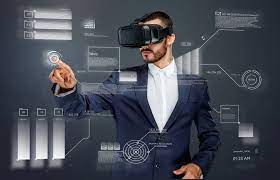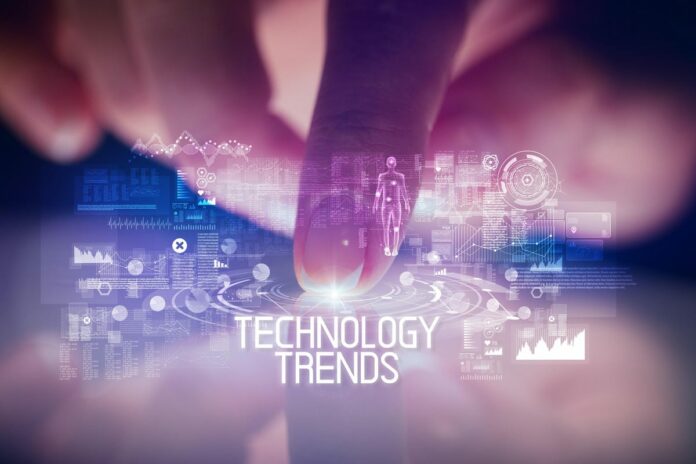Best and New technology trends will be described in this article. Was 2021 the year with the most remarkable technology developments and newsworthy breakthroughs? This sounds like a huge boast, but let’s face the reality: the last year saw discoveries that are often the stuff of science fiction novels. These featured the first gene-edited children, AI that can detect diseases, and subatomic particles. Virtual reality and artificial intelligence have continued to be among the industries with the fastest net worth growth over the past year. It seems certain that:
Top 9 New Technology Trends In 2022
Top 9 New Technology Trends are explained here.
Is there a cap on the rate of technological technology?
Here is TechJury’s prediction for the future.
1. Artificial Intelligence (AI)

The cybersecurity sector will benefit greatly from AI. AI can help cybersecurity specialists overcome some of their biggest pain areas because data leaks occur frequently.
Machine learning is an essential component of automation, which is what artificial intelligence is all about. It enables machines to watch us and take behaviour cues from us. The most recent computer technology can forecast data breaches and identify patterns in hacker attacks before they happen. Also check Benefits of Digital Technology
The idea of artificial intelligence is by no means new or original. Many large corporations are already utilising AI in their daily operations, and research on the technology has been continuing for better than 60 years. It’s still expensive to build AI because it’s still a difficult problem to solve. Making this technology accessible to the general people will be the main problem of 2022.
Medicare has been making significant investments in AI, and the results have been excellent. In addition to being essential for the advancement of humanity, scientific investigations in disciplines like neurolinguistic programming, biotechnology, and neural networks are also steadily broadening the labour market.
Artificial intelligence also has a lot to offer the transportation and logistics industries.
The improved interoperability between the collection of neural networks used to support artificial intelligence is another development worth highlighting. When it comes to picking the multiple suitable foundation for their AI systems, developers are having trouble. In light of this, an AI model that has been trained in a particular framework frequently struggles when attempting to switch to a different network. Because of this, system developers are working to improve interoperability. More powerful AI systems will most likely result from this.
So, where is technology headed in terms of its adoption? According to researchers, in 2022, more companies will think about integrating AI-based solutions, particularly for marketing objectives like customer support, retention, and engagement. This trend is very intriguing because it seems like client involvement is a task best left to people. However, the use of AI in this situation is expected to result in significant man-hour savings as well as shorter wait times for clients who need more information.
General tech-related procedures, research initiatives, development, and security are additional corporate contexts where AI adoption is occurring. Scheduling, predictive maintenance, and improving energy efficiency will all be significantly impacted by AI in 2022. The finest part, though, is not that:
This technological trend will generate a tonne of new jobs as it is developed and optimised.
Programmers and developers of machine learning systems are among the top rising career categories, with over 2000 active and lucrative listings on LinkedIn. While there will definitely be job losses in the manual labour sectors as a result of increasing automation, approximately 58 million new employment are anticipated to be created before 2030. This is another technology trends.
2. Blockchain

The first something that generally comes to mind when someone says “blockchain” is “bitcoin.” That shouldn’t come as a big surprise as the financial and banking industries were the first to use blockchain technology. The fact is that blockchain encompasses far more than just bitcoin.
While it does drive bitcoin, the main way it drives the current trend is through a decentralised network of ledgers, which are continuously expanding computer records. Even if someone were to obtain unauthorised access, they would not be able to piece anything significant together because each ledger only holds a small portion of the data.
Cybersecurity is another industry that is eagerly watching the progress of blockchain technology. It is the ideal illustration of how blockchain technology may be used in areas other than banking. In our rapidly digitalized society, there are worrying reports of data breaches every day. Due to its ability to preserve your privacy, blockchain may become one of the hottest technology trends.
The benefits of blockchain can take many different forms and shapes. For example, the food business will gain from increased openness and stronger client-vendor connections, while the voting process may change and become less susceptible to rigging.
In summary, there is a lot of unrealized potential in the blockchain, and 2022 will surely be another step in that direction.
3. Internet of Things (IoT)

The internet of things is a further technology that has been around for some time but has not yet reached its full potential (IoT).
Consider the following scenario: You are on your way to deliver a presentation to your department as a whole when you are unexpectedly caught in a traffic bottleneck that seems to drag on for miles.
Not to be concerned.
This is another technology trends. Your phone will be able to identify the delay and send information to your work PC thanks to new technology. It will choose the ideal time to reschedule the meeting and notify your coworkers so they don’t merely wait around in vain. Your vehicle will adjust to the current traffic conditions and reduce fuel consumption in the interim.
Sounds like a design from a science fiction film, but IoT is more than capable of doing that.
Check out this post for more additional details if you want to learn more about the new IoT technology trends for 2022.
4. Virtual Reality & Augmented Reality

In the 1950s, when it was originally introduced, virtual reality had a rocky beginning. In various fields, there have been substantial advancements in recent decades in terms of quality and utility. The technology is still prohibitively pricey for widespread use. Also check Client Portal software
Although the market has expanded a little, the majority of users of VR equipment do so more for pure curiosity than for practical utility or amusement. At present time, neither enterprises nor individual consumers are embracing VR at very high rates.
Is virtual reality progressing in the correct way? The AR market is expected to reach $340 billion by 2028, according to the most recent tech trends, while the VR market generated sales of up to $75 billion in 2021.
These enormous figures reflect a lot of developments in VR and augmented reality technology. Mobile integration is AR’s secret weapon. Since no equipment is required, using AR apps on smartphones and tablets will make the technology more widely available. Several augmented reality (AR) tools are currently downloadable through smartphone app stores, and app development is picking up speed. All critics concur that Pokémon Go is the best augmented reality app to date. Even yet, the technology at the time the game was released was rather primitive. More immersive AR-based games and apps are something we may anticipate by looking at the technology trends of 2022.
In terms of virtual reality, it’s clear that the fad isn’t living up to the expectations. Some individuals think that the poor quality of the headsets and software that were initially introduced is the causality of the lack of popularity. However, other headsets, such as the Oculus Rift, offer reliable and cheap gaming solutions.
The general public likely has higher expectations, which developers haven’t met thus far. However, technology advances each time, and the newest trends for 2022 promise greater answers. Better content sync is the first step towards integrating VR into our daily lives. In light of this, users of current VR headsets cannot fully immerse themselves in the experience. Although the equipment is accessible, it has only been applied in certain niches.
We should soon notice a more intelligent application of AR in our daily lives as time goes on. Researchers believe that AR has enormous business potential, particularly in sectors like manufacturing and advertising. AR-based advertising will appear quite cool. or incredibly infuriating.
Simulator software will soon be useful to government agencies other than the military. It will also have an impact on industries including entertainment, education, and architecture.
Commercial headphones and software are already getting better. According to current technical trends, headsets with better screens, more sensors, Wi-Fi capabilities, and other features will be available within the next one to two years.
Australians have already put this technology to inventive use. A local business that specialises in training solutions, FLAIM Systems, has created an app for teaching firefighters that blends IoT and VR.
5. Smart Spaces
We use smart wearables, smart speakers, carry smartphones in our pockets, and rely on smart home security systems. This is another technology trends.
What makes sense to do next?
Let’s talk about smart spaces!
One of the newest technological trends, smart spaces are closely related to the development of IoT. In less than two years, the digit of devices connected to the IoT network will surpass the 30 billion mark, opening up new possibilities for fully digitalizing homes and workplaces.
According to sociological surveys, more than 1 billion people would have abandoned their fixed desks by the end of 2020. This implies that at least 13% of the world’s population will be interested in using spaces that can be altered to suit their individual requirements.
Next, dare we fantasise about smart cities?
6. 5G Networks

Without the most recent advancements in mobile, no list of upcoming tech trends would be complete.
All eyes are on 5G this year.
Increased speeds and minimal latency are promised by the mobile communications standard of the next generation. Given that we use our phones for a greater variety of activities than ever before, that is fantastic news.
In order to put things in perspective, 5G networks have been actively being developed for more than ten years. Providers are now beta testing their networks, and according to forecasts, 5G will start to roll out in a number of locations this year. According to 2022 technology trends, a full launch will happen shortly.
Smartphones and other gadgets will have access to much quicker and more dependable internet connections thanks to 5G. The typical download speed is around 1GB/s, and the overall network bandwidth has been greatly enhanced.
The middle internet speed in the world is only 10MB/s right now, thus 5G may potentially provide a connection that is 100 times faster.
But things continue to improve. While some networks have already offered speeds over 500GB/s, tests demonstrate that 5G networks can sustain simultaneous connections at 10GB/s. The timeframe for technology’s development will assure that internet connection speeds are no longer a worry.
However, because 5G and IoT can work wonderfully together, the adoption trend for 5G won’t just result in quicker downloads and smoother streaming. Because of its enormous capacity, it’s a great option for establishing connections between internet of things devices or supporting cutting-edge technology like driverless vehicles or smart cities.
We should expect some significant changes in the near future, including telemedicine, remote-controlled heavy machinery, and autonomous vehicles that “talk” with one another on the road. By the end of 2021 or the start of 2022, AT&T and Verizon hope to have this new technology nationwide. They are already prepared to roll it out.
You might be wondering where 5G will be made available first. Well, the United States, South Korea, Japan, China, and a few European nations are all actively making advancements.
According to the most recent information technology trends, smartphone manufacturers will have to change their products in order to support the technology of 5G in 2020. As a result, 5G will probably be available by default. Some analysts have mentioned a transitional phase during which devices with 4.5G capability will launch (LTE-A). Nevertheless, the majority of smartphone producers are already testing 5G-capable gadgets.
7. Automotive
Major automakers have already dipped their toes in the electric car industry after realising the value of “clean” energy rather quickly. Sales in the US virtually tripled in the previous year, and in the next ten years, the digit of electric vehicles is predicted to increase from 3 million to 25 million. The crucial query is: How can we all work to contribute to a greener future?
Will the upcoming technological trends in 2022 spell the end for the internal combustion engine? That is how it seems, isn’t it? Also check Tech trends
The quantity of electric automobiles has increased recently. Although top EV manufacturers like Tesla are selling a sizable number of vehicles, there are many smaller automakers as well. Given the many advantages that electric cars offer, this is completely natural. These include quick torque, no emissions, financial incentives from the government, and cheaper gas prices. Despite these benefits, there are still not many EVs compared to cars with combustion engines.
Where is EV technology headed, then?
A number of trends will facilitate the adoption of EVs on a global scale. Improved EVs and better infrastructure are two significant advances we may anticipate in the next two years. The EV market has primarily targeted sedans and compact automobiles thus far. As manufacturers increase production, automobile customers will have more options in the coming years.
Another problem the EV sector is facing has to do with range. Tesla easily triumphs in this instance, and the competition appears distant. If EVs are to take the place of conventional combustion-engine vehicles, consumers need longer ranges.
As a result, battery technology has substantial R&D, which opens up new opportunities for innovation. Future technology will probably make it possible for EVs to become the norm by 2050.
In terms of actual EV purchasing costs, 2022 won’t see a significant drop. However, buyers can anticipate a steady drop in price, which is also necessary for widespread adoption. Hopefully, government incentives will remain in place.
This is another technology trends. Last but not least, there are still not many charging stations, especially when compared to how many petrol stations there are. However, charging stations are beginning to appear all over the place. Infrastructure will undoubtedly get better as market demand rises.
A self-driving car Renaissance also appears to be on the horizon. Future technology trends point to a rise in interest and effort in development. Only two years ago, Google subsidiary Waymo began to deploy its fleet of autonomous test vehicles. They already operate the first legally operating commercial autonomous taxi service. The US government is appropriately adjusting to this issue and has already added new provisions to their traffic rules for autonomous vehicles.
In a nutshell, the automotive sector is anticipating a cleaner, safer, and more intelligent future.
8. Medicare
AI and healthcare have a long-standing, unbreakable relationship. Investments in technology and trends in the tech sector had a significant role in bringing us out of the stone age, particularly through curing ailments that had afflicted mankind since the beginning of time.
However, there is still a protracted way to go.
Big Pharma firms will soon use AI-driven technology to streamline the drug delivery process, which will enhance communication between customers and medicine suppliers. Medical experts will be able to provide us with personalised information directly, and we will be able to provide them with quick feedback.
There are numerous digital technology trends that have a direct impact on the healthcare sector. Just last year, the FDA licenced firms like Imagen, Viz.AI, and IDx (researchers in the field of autonomous eye illness diagnosis), among others (AI application in medical image analysis).
Perhaps a significant increase in life expectancy will help us go from science fiction to reality.
9. Digital Ethics & Privacy
Even though this trend has nothing to do with new software or technological advancements, it is perhaps one of the most significant and pertinent IT topics to pay attention to. In a nutshell, digital ethics is the study of how technology affects society and determines the best method for incorporating technology into our daily lives. It mainly focuses on the moral implications of present and emerging technology, as well as the upcoming digital technology trends of 2021. This is another technology trends.
Self-driving automobiles are the most pertinent illustration of digital ethics today. Therefore, should an autonomous vehicle try to save the passenger by running over a pedestrian in the event of an impending collision? Or should it bring about a collision that could be catastrophic for the “driver,” rescuing the pedestrian in the process? Who is additionally accountable in court in the event of an accident?
Digital ethics makes an effort to provide answers to these queries.
Artificial intelligence is a topic of discussion in digital ethics. AI machines will have a lot of power once general intelligence-capable neural networks are developed. In this situation, it’s crucial to assess their level of intelligence and come up with answers to the various problems an AI might face. It’s possible that innovations in technology in the future will have digital ethics at their foundation.
Concern over privacy is also rising. In a world where monitoring can be activated at the touch of a button, how can you guarantee privacy and freedom of speech? Numerous businesses have so far collected private information for advertising purposes, but is this ethical?
How can we safeguard the private information on our devices?
Who ensures that governments and tech businesses don’t misuse the right to privacy?
Unfortunately, we don’t currently know the appropriate answers to these queries. This just illustrates how relevant digital ethics and privacy are for society as a whole.
Closing Thoughts
Big data appears to be the connecting factor for all emerging technologies. There is already a tonne of data on the Web. No pressure or anything, but how we handle it could affect how mankind evolves as a whole.

